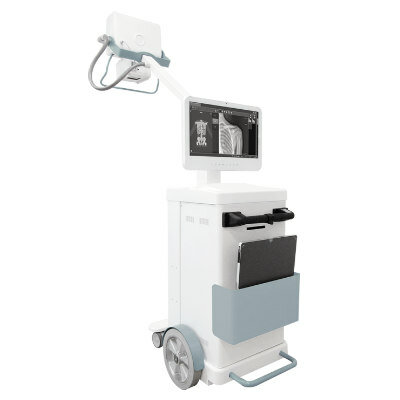Ultrasound-Assisted Optical Imaging Could Replace Endoscopy
|
By MedImaging International staff writers Posted on 01 Aug 2019 |

Image: Ultrasound could soon be used to provide optical images of internal structures (Photo courtesy of Maysam Chamanzar/ CMU).
A new study suggests that ultrasound could be used to optically image internal organs, potentially eliminating the need for invasive visual exams using endoscopic cameras.
Developed by researchers at Carnegie Mellon University (CMU; Pittsburgh, PA, USA), the new technique uses ultrasonic wave patterns to change the local density of the tissues so as to create a graded refractive index pattern in the direction of light propagation, which modulates the phase front of light. Thus causes it to focus within the medium, effectively creating a virtual gradient index (GRIN) lens relay. The virtual GRIN lens can be moved around simply by reconfiguring the ultrasound wave patterns from outside the body, enabling the imaging of different target regions, all noninvasively.
The focal distance and the numerical aperture of the sculpted optical GRIN lens can also be tuned, by changing the ultrasonic wave parameters. The researchers demonstrate that the virtual GRIN lens can resolve small features (22 µm) even through a turbid medium (which is normally opaque), continuously scanning over a depth of 5.4 mm in the modulated medium. The researchers claim the technology could eventually be implemented in the form of a handheld device or wearable surface patch that images the brain or under the skin. The study was published on July 17, 2019, in Light: Science and Applications.
“Being able to relay images from organs such as the brain without the need to insert physical optical components will provide an important alternative to implanting invasive endoscopes in the body,” said co-lead author Maysam Chamanzar, PhD. “We used ultrasound waves to sculpt a virtual optical relay lens within a given target medium, which for example, can be biological tissue. Therefore, the tissue is turned into a lens that helps us capture and relay the images of deeper structures. This method can revolutionize the field of biomedical imaging.”
“Turbid media have always been considered obstacles for optical imaging, but we have shown that such media can be converted to allies to help light reach the desired target,” said co-lead author PhD student Matteo Giuseppe Scopelliti, MSc. “When we activate ultrasound with the proper pattern, the turbid medium becomes immediately transparent. It is exciting to think about the potential impact of this method on a wide range of fields, from biomedical applications to computer vision.”
GRIN lenses do not require an air gap to function since the operation of the lens is due to varying indices in the lens itself, rather than the difference in indices between the air and lens. Additionally, in a GRIN lens, all optical paths are the same due to the radially varying refractive index, in contrast to a spherical or aspheric lens.
Related Links:
Carnegie Mellon University
Developed by researchers at Carnegie Mellon University (CMU; Pittsburgh, PA, USA), the new technique uses ultrasonic wave patterns to change the local density of the tissues so as to create a graded refractive index pattern in the direction of light propagation, which modulates the phase front of light. Thus causes it to focus within the medium, effectively creating a virtual gradient index (GRIN) lens relay. The virtual GRIN lens can be moved around simply by reconfiguring the ultrasound wave patterns from outside the body, enabling the imaging of different target regions, all noninvasively.
The focal distance and the numerical aperture of the sculpted optical GRIN lens can also be tuned, by changing the ultrasonic wave parameters. The researchers demonstrate that the virtual GRIN lens can resolve small features (22 µm) even through a turbid medium (which is normally opaque), continuously scanning over a depth of 5.4 mm in the modulated medium. The researchers claim the technology could eventually be implemented in the form of a handheld device or wearable surface patch that images the brain or under the skin. The study was published on July 17, 2019, in Light: Science and Applications.
“Being able to relay images from organs such as the brain without the need to insert physical optical components will provide an important alternative to implanting invasive endoscopes in the body,” said co-lead author Maysam Chamanzar, PhD. “We used ultrasound waves to sculpt a virtual optical relay lens within a given target medium, which for example, can be biological tissue. Therefore, the tissue is turned into a lens that helps us capture and relay the images of deeper structures. This method can revolutionize the field of biomedical imaging.”
“Turbid media have always been considered obstacles for optical imaging, but we have shown that such media can be converted to allies to help light reach the desired target,” said co-lead author PhD student Matteo Giuseppe Scopelliti, MSc. “When we activate ultrasound with the proper pattern, the turbid medium becomes immediately transparent. It is exciting to think about the potential impact of this method on a wide range of fields, from biomedical applications to computer vision.”
GRIN lenses do not require an air gap to function since the operation of the lens is due to varying indices in the lens itself, rather than the difference in indices between the air and lens. Additionally, in a GRIN lens, all optical paths are the same due to the radially varying refractive index, in contrast to a spherical or aspheric lens.
Related Links:
Carnegie Mellon University
Latest Ultrasound News
- Deep Learning Advances Super-Resolution Ultrasound Imaging
- Novel Ultrasound-Launched Targeted Nanoparticle Eliminates Biofilm and Bacterial Infection
- AI-Guided Ultrasound System Enables Rapid Assessments of DVT
- Focused Ultrasound Technique Gets Quality Assurance Protocol
- AI-Guided Handheld Ultrasound System Helps Capture Diagnostic-Quality Cardiac Images
- Non-Invasive Ultrasound Imaging Device Diagnoses Risk of Chronic Kidney Disease
- Wearable Ultrasound Platform Paves Way for 24/7 Blood Pressure Monitoring On the Wrist
- Diagnostic Ultrasound Enhancing Agent to Improve Image Quality in Pediatric Heart Patients
- AI Detects COVID-19 in Lung Ultrasound Images
- New Ultrasound Technology to Revolutionize Respiratory Disease Diagnoses
- Dynamic Contrast-Enhanced Ultrasound Highly Useful For Interventions
- Ultrasensitive Broadband Transparent Ultrasound Transducer Enhances Medical Diagnosis
- Artificial Intelligence Detects Heart Defects in Newborns from Ultrasound Images
- Ultrasound Imaging Technology Allows Doctors to Watch Spinal Cord Activity during Surgery

- Shape-Shifting Ultrasound Stickers Detect Post-Surgical Complications
- Non-Invasive Ultrasound Technique Helps Identify Life-Changing Complications after Neck Surgery
Channels
Radiography
view channel
Novel Breast Imaging System Proves As Effective As Mammography
Breast cancer remains the most frequently diagnosed cancer among women. It is projected that one in eight women will be diagnosed with breast cancer during her lifetime, and one in 42 women who turn 50... Read more
AI Assistance Improves Breast-Cancer Screening by Reducing False Positives
Radiologists typically detect one case of cancer for every 200 mammograms reviewed. However, these evaluations often result in false positives, leading to unnecessary patient recalls for additional testing,... Read moreMRI
view channel
PET/MRI Improves Diagnostic Accuracy for Prostate Cancer Patients
The Prostate Imaging Reporting and Data System (PI-RADS) is a five-point scale to assess potential prostate cancer in MR images. PI-RADS category 3 which offers an unclear suggestion of clinically significant... Read more
Next Generation MR-Guided Focused Ultrasound Ushers In Future of Incisionless Neurosurgery
Essential tremor, often called familial, idiopathic, or benign tremor, leads to uncontrollable shaking that significantly affects a person’s life. When traditional medications do not alleviate symptoms,... Read more
Two-Part MRI Scan Detects Prostate Cancer More Quickly without Compromising Diagnostic Quality
Prostate cancer ranks as the most prevalent cancer among men. Over the last decade, the introduction of MRI scans has significantly transformed the diagnosis process, marking the most substantial advancement... Read moreNuclear Medicine
view channel
New SPECT/CT Technique Could Change Imaging Practices and Increase Patient Access
The development of lead-212 (212Pb)-PSMA–based targeted alpha therapy (TAT) is garnering significant interest in treating patients with metastatic castration-resistant prostate cancer. The imaging of 212Pb,... Read moreNew Radiotheranostic System Detects and Treats Ovarian Cancer Noninvasively
Ovarian cancer is the most lethal gynecological cancer, with less than a 30% five-year survival rate for those diagnosed in late stages. Despite surgery and platinum-based chemotherapy being the standard... Read more
AI System Automatically and Reliably Detects Cardiac Amyloidosis Using Scintigraphy Imaging
Cardiac amyloidosis, a condition characterized by the buildup of abnormal protein deposits (amyloids) in the heart muscle, severely affects heart function and can lead to heart failure or death without... Read moreGeneral/Advanced Imaging
view channel
New AI Method Captures Uncertainty in Medical Images
In the field of biomedicine, segmentation is the process of annotating pixels from an important structure in medical images, such as organs or cells. Artificial Intelligence (AI) models are utilized to... Read more.jpg)
CT Coronary Angiography Reduces Need for Invasive Tests to Diagnose Coronary Artery Disease
Coronary artery disease (CAD), one of the leading causes of death worldwide, involves the narrowing of coronary arteries due to atherosclerosis, resulting in insufficient blood flow to the heart muscle.... Read more
Novel Blood Test Could Reduce Need for PET Imaging of Patients with Alzheimer’s
Alzheimer's disease (AD), a condition marked by cognitive decline and the presence of beta-amyloid (Aβ) plaques and neurofibrillary tangles in the brain, poses diagnostic challenges. Amyloid positron emission... Read more.jpg)
CT-Based Deep Learning Algorithm Accurately Differentiates Benign From Malignant Vertebral Fractures
The rise in the aging population is expected to result in a corresponding increase in the prevalence of vertebral fractures which can cause back pain or neurologic compromise, leading to impaired function... Read moreImaging IT
view channel
New Google Cloud Medical Imaging Suite Makes Imaging Healthcare Data More Accessible
Medical imaging is a critical tool used to diagnose patients, and there are billions of medical images scanned globally each year. Imaging data accounts for about 90% of all healthcare data1 and, until... Read more
Global AI in Medical Diagnostics Market to Be Driven by Demand for Image Recognition in Radiology
The global artificial intelligence (AI) in medical diagnostics market is expanding with early disease detection being one of its key applications and image recognition becoming a compelling consumer proposition... Read moreIndustry News
view channel
Bayer and Google Partner on New AI Product for Radiologists
Medical imaging data comprises around 90% of all healthcare data, and it is a highly complex and rich clinical data modality and serves as a vital tool for diagnosing patients. Each year, billions of medical... Read more



















